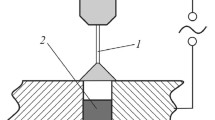Conclusions
-
1.
Formation of a Al−Cu-joint structure made by butting contact fusion welding occurs by a soldering mechanism, i.e., welding with development in the joint of hypereutectic alloy.
-
2.
The structure of the transition zone of joints made by friction welding consists of a solid solution of copper in aluminum with a very small amount (∼1.5%) θ-phase which provides quite high strength properties for these joints.
Similar content being viewed by others
Literature cited
A. E. Vol, Structure and Properties of Binary Metal Systems, Vol. 1 [in Russian], Fizmatgiz, Moscow (1959).
Additional information
ZIL Factory Higher Technical School. ZIL Production Association. Translated from Metallovedenie i Termicheskaya Obrabotka Metallov, No. 12, pp. 34, December, 1990.
Rights and permissions
About this article
Cite this article
Mozhaiskaya, T.M., Chekanova, N.T. Structure and properties of welded aluminum-copper joints. Met Sci Heat Treat 32, 938–939 (1990). https://doi.org/10.1007/BF00700088
Issue Date:
DOI: https://doi.org/10.1007/BF00700088




